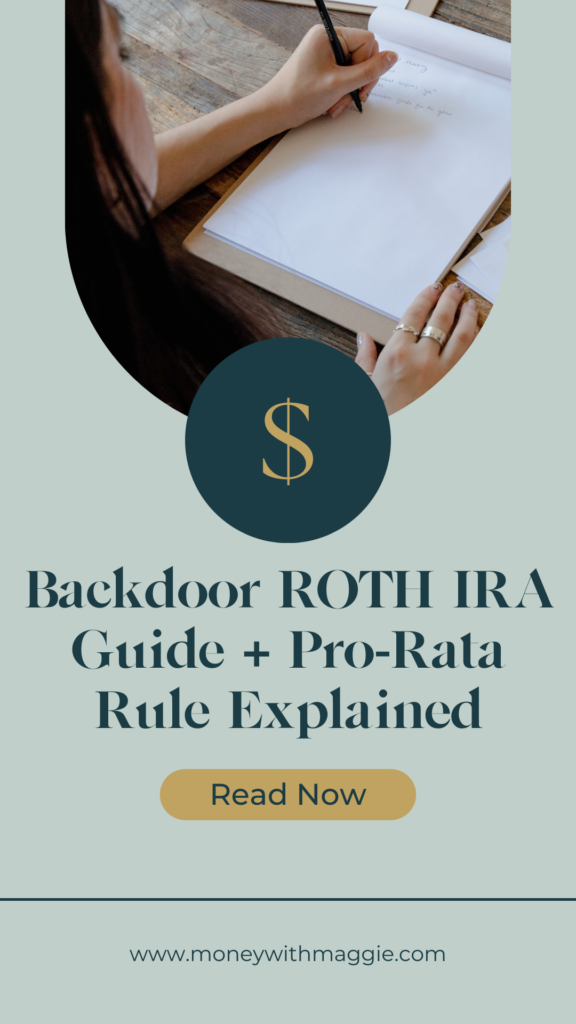A backdoor Roth is a strategy for getting money into a Roth IRA if you’ve exceeded the income limits to contribute directly by transferring money from a traditional IRA. In this process, the pro-rata rule applies. Read this article to learn how it all works.

First off, what is a Roth IRA?
IRA stands for Individual Retirement Account and Roth is the name of the one who came up with it. It’s a retirement fund where you invest after-tax money and let it grow without worrying about having to pay any more tax (even when you pull it out).
A backdoor Roth is a strategy for getting money into a Roth IRA if you’ve exceeded the income limits to contribute directly.
We are going to cover what a backdoor Roth is, how to create one, and how taxes work with them- including the pro-rata rule. Which does complicate things but don’t worry I got you, so grab a notebook, a pen, your calculator and let’s get into it.
If you’ve made over $144k in 2022 or $153k in 2023 you’re no longer allowed to contribute directly to a Roth IRA, so in order to get in, you have to go through the back door. A backdoor Roth isn’t a type of account, so you won’t see it as an option when trying to open an account.
This can sound overwhelming, but just pause and read over this again. Things will eventually click the more your lean into learning.
Step 1: Open a traditional IRA.
Or you can use an existing IRA that you already own.
Step 2: Put money into the IRA.
You can deposit up to $6,000 in 2022 or $6,500 in 2023 and an additional $1,000 if you’re over 50. A note on this step is that if you already have a traditional IRA with pre-tax money, meaning you received a deduction when you put money in, then the pro rata rule is likely going to apply when you do the backdoor Roth, but we’ll get to that in a bit.
Step 3: Call your investment firm’s support line.
Let them know you’d like help processing a Roth conversion. This is technically what you’re doing when you move the money from the traditional IRA into the Roth — you’re converting the funds.
Step 4: Let your investment firm move the money from the traditional IRA over to a Roth account.
They may have you open a Roth IRA or they may automatically open one for you. When they process the transfer, they code the account as a conversion for the IRS.
That’s it for the actual conversion.
Now, let’s get into how taxes work with the backdoor roth.
Remember that with a Roth IRA you don’t get a tax deduction for your contributions, but in retirement, both your contributions and growth get to come out income tax-free. This is the benefit of going through the process of doing a backdoor roth, so you’ll have some tax free income in retirement.
With a traditional IRA, you receive a deduction when you put money into the account as long as you fall under certain income limits set by the IRS. If you’re at the point where you’re no longer allowed to contribute to a Roth IRA directly, you’re definitely past the point where you can take a deduction for a traditional IRA.
This is why you’d want to get your money into a Roth IRA so you benefit from the growth coming out income tax-free later.
There’s no cap on how much you can make to be able to contribute to the traditional IRA. There are also no income limits for being able to convert traditional IRA money to Roth money. That’s what makes the backdoor Roth a tax loophole and something to take advantage of while it lasts.
Let’s look at 2 separate scenarios to understand how taxes will work with your situation:
#1: You don’t have an existing IRA with money in it. This is when things are simple. Just follow the steps I listed earlier and you’re done. There are no taxes owed since you never received a deduction for the money you’re putting into the IRA.
#2: You have an existing IRA or multiple IRAs that you’ve made contributions to and received a tax deduction for. Perhaps they were established when you were at a lower income or rolled money from an employer-sponsored plan to an IRA. The backdoor Roth gets complicated here because the pro-rata rule applies. This means you’ll have to pay tax based on the proportion of after-tax vs before-tax contributions you’ve made.
When it comes to the pro-rata rule, the IRS will look at all of your IRAs as one to determine how much income gets to come out tax-free vs taxable. This is good so you don’t get double taxed, but makes the process challenging.
The funds that you move into a Roth IRA will be considered taxed both in the Roth and as well as your traditional IRA.
For example, you had $36K in your traditional IRAs and moved $6,000 to a Roth IRA and out of those funds $5,004 was taxed. That means that $5,004 out of your remaining $30K of traditional IRAs is also counted as taxed.
So, at retirement it will reduce the amount of tax you’ll pay because again calculations will be done to determine how much gets to come out income tax free and how much should be taxed — ultimately giving you a tax-avoidance opportunity.
Each year going forward the same process needs to be done.
One way to avoid having to do this is to convert the entire traditional IRA balance in one year and deal with all the taxes at once. This may bump you into a higher tax bracket though, so you’ll have to run some numbers, ideally with a tax advisor to determine your best approach.
Another way is through a reverse rollover where you move your IRA into your employer-sponsored plan. You have to check to see if this is allowed with your employer, but if it is, it could be a great way to avoid dealing with the pro-rata rule.
This article might have a lot of information to process. If you have questions, or need help with calculating conversions, I’m always here to lend a helping hand.
Not to mention, if you’re wondering how much money you need to retire comfortably, read my blogpost on it here.

need help investing?
Let's Get Started Investing, Together.
Browse my best selling courses to get a solid foundation on how to start investing and preparing for your future!
PLEASE COMMENT BELOW